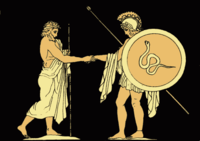Iolcus
Iolcus
Iωλκός | |
|---|---|
UTC+3 (EEST) | |
| Postal code | 385 00 |
| Area code(s) | 24210 |
| Vehicle registration | ΒΟ |
| Website | www.iolkos.gr |
Iolcus ( The seat of the former municipality was the village of Ano Volos.
Mythology


According to ancient Greek mythology, Aeson was the rightful king of Iolcus, but his half-brother Pelias usurped the throne. It was Pelias who sent Aeson's son Jason and his Argonauts to look for the Golden Fleece. The ship Argo set sail from Iolcus with a crew of fifty demigods and princes under Jason's leadership. Their mission was to reach Colchis in Aea at the eastern seaboard of the Black Sea and to reclaim and bring back the Golden Fleece.
Along with the Golden Fleece, Jason brought a wife, the sorceress
Iolcus is mentioned by
History
In antiquity, Iolcus was situated in
Site
The position of Iolcus is indicated by Strabo, who says that it was on the road from
Ancient Iolcus' location is at the Volos Kastro,[17][18] located at 39°21′59″N 22°58′08″E / 39.366305°N 22.96886°E.[18]
Historical population
| Year | Pop. | ±% |
|---|---|---|
| 1991 | 2,415 | — |
| 2001[3] | 2,081 | −13.8% |
| 2011[19] | 2,138 | +2.7% |
| 2021[1] | 2,008 | −6.1% |
See also
References
- ^ a b c "Αποτελέσματα Απογραφής Πληθυσμού - Κατοικιών 2021, Μόνιμος Πληθυσμός κατά οικισμό" [Results of the 2021 Population - Housing Census, Permanent population by settlement] (in Greek). Hellenic Statistical Authority. 29 March 2024.
- ^ "ΦΕΚ B 1292/2010, Kallikratis reform municipalities" (in Greek). Government Gazette.
- ^ a b "Population & housing census 2001 (incl. area and average elevation)" (PDF) (in Greek). National Statistical Service of Greece. Archived (PDF) from the original on 2015-09-21.
- ^ Homer. Iliad. Vol. 2.712.
- ^ Homer. Odyssey. Vol. 11.256.
- Pseudo-Apollodorus, 1.9.11
- ^ Strabo. Geographica. Vol. ix. p.414. Page numbers refer to those of Isaac Casaubon's edition.
- ISBN 0-19-814099-1.
- ^ Herodotus. Histories. Vol. 5.94.
- ^ Periplus of Pseudo-Scylax 65.
- ^ a b Strabo. Geographica. Vol. 9.5.15. Page numbers refer to those of Isaac Casaubon's edition.
- ^ ὁ τῆς Ἰωλκοῦ τόπος, Strabo. Geographica. Vol. ix. p.438. Page numbers refer to those of Isaac Casaubon's edition.
- ^ Strabo. Geographica. Vol. ix. p.438. Page numbers refer to those of Isaac Casaubon's edition.
- ^ a b Strabo. Geographica. Vol. ix. p.436. Page numbers refer to those of Isaac Casaubon's edition.
- ^ Pindar N. 4.88.
- Ab urbe condita Libri[History of Rome]. Vol. 44.12, 13.
- ISBN 978-0-691-03169-9.
- ^ a b Lund University. Digital Atlas of the Roman Empire.
- ^ "Απογραφή Πληθυσμού - Κατοικιών 2011. ΜΟΝΙΜΟΣ Πληθυσμός" (in Greek). Hellenic Statistical Authority.
![]() This article incorporates text from a publication now in the public domain: Smith, William, ed. (1854–1857). "Iolcus". Dictionary of Greek and Roman Geography. London: John Murray.
This article incorporates text from a publication now in the public domain: Smith, William, ed. (1854–1857). "Iolcus". Dictionary of Greek and Roman Geography. London: John Murray.
